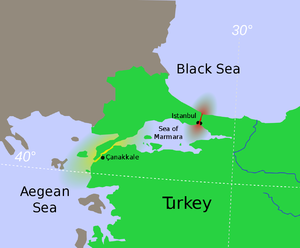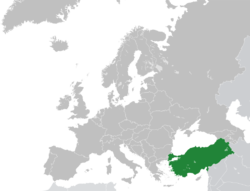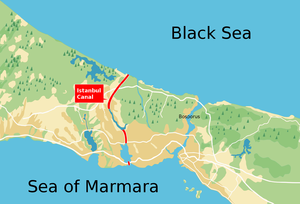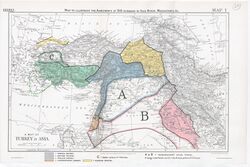Difference between revisions of "Turkish Straits"
(strategic waterway) |
(→Montreux Convention: FA to full article) |
||
| (One intermediate revision by one other user not shown) | |||
| Line 15: | Line 15: | ||
==Montreux Convention== | ==Montreux Convention== | ||
| + | {{FA|Montreux Convention}} | ||
The '''Montreux Convention Regarding the Regime of the Straits''' is a 1936 agreement that gives [[Turkey]] control over the [[Bosporus]] and [[Dardanelles]] [[strait]]s and regulates the transit of naval warships. The Convention guarantees the free passage of civilian vessels in peacetime, and restricts the passage of naval ships not belonging to [[Black Sea]] states. | The '''Montreux Convention Regarding the Regime of the Straits''' is a 1936 agreement that gives [[Turkey]] control over the [[Bosporus]] and [[Dardanelles]] [[strait]]s and regulates the transit of naval warships. The Convention guarantees the free passage of civilian vessels in peacetime, and restricts the passage of naval ships not belonging to [[Black Sea]] states. | ||
| Line 22: | Line 23: | ||
==Turkish Straits crisis== | ==Turkish Straits crisis== | ||
| − | In the years after [[World War 2]], the waterways were at the center of a [[psychological operation]] to make Turkey join [[NATO]]. Soviet requests for a renegotiation of some aspects of the management after the experiences during the war were presented as demands for military control over the area and a threat of an imminent Soviet invasion. Later studies have shown how this was purposely contrived to create the conditions for Turkish acceptance of the [ | + | In the years after [[World War 2]], the waterways were at the center of a [[psychological operation]] to make Turkey join [[NATO]]. Soviet requests for a renegotiation of some aspects of the management after the experiences during the war were presented as demands for military control over the area and a threat of an imminent Soviet invasion. Later studies have shown how this was purposely contrived to create the conditions for Turkish acceptance of the [[Truman doctrine]] and later NATO membership. |
{{FA|Turkish Straits crisis}} | {{FA|Turkish Straits crisis}} | ||
Latest revision as of 22:36, 5 March 2022
(Straits, Strategic waterway) | |
|---|---|
 | |
 | |
| Locations | Turkey |
| Strategic waterway | |
The Turkish Straits are two internationally significant waterways in northwestern Turkey. The straits create a series of international passages that connect the Aegean and Mediterranean seas to the Black Sea. They consist of the Dardanelles and the Bosphorus. The straits are on opposite ends of the Sea of Marmara. The straits and the Sea of Marmara are part of the sovereign sea territory of Turkey and subject to the regime of internal waters.
Located in the western part of the landmass of Eurasia, the Turkish Straits are conventionally considered the boundary between the continents of Europe and Asia, as well as the dividing line between European Turkey and Asian Turkey. Owing to their strategic importance in international commerce, politics, and warfare, the Turkish Straits have played a significant role in European and world history.
Contents
Montreux Convention
- Full article: Montreux Convention
- Full article: Montreux Convention
The Montreux Convention Regarding the Regime of the Straits is a 1936 agreement that gives Turkey control over the Bosporus and Dardanelles straits and regulates the transit of naval warships. The Convention guarantees the free passage of civilian vessels in peacetime, and restricts the passage of naval ships not belonging to Black Sea states.
As mentioned in the preamble, the Convention annulled the previous Lausanne Treaty on the Straits dictated after the Ottoman loss in WW1, which stated the demilitarization of the Greek islands of Lemnos and Samothrace along with the demilitarization of the Dardanelles, the Sea of Marmara and the Bosporus, and the Turkish islands of İmroz, Bozcaada and Tavşan.
The International Straits Commission was abolished, authorising the full resumption of Turkish military control over the Straits and the refortification of the Dardanelles. Turkey was authorised to close the Straits to all foreign warships in wartime or when it was threatened by aggression. Also, it was authorised to refuse transit from merchant ships belonging to countries at war with Turkey.
Turkish Straits crisis
In the years after World War 2, the waterways were at the center of a psychological operation to make Turkey join NATO. Soviet requests for a renegotiation of some aspects of the management after the experiences during the war were presented as demands for military control over the area and a threat of an imminent Soviet invasion. Later studies have shown how this was purposely contrived to create the conditions for Turkish acceptance of the Truman doctrine and later NATO membership.
- Full article:
 Turkish Straits crisis
Turkish Straits crisis
- Full article:
Istanbul Canal
The Istanbul Canal is a project for the artificial sea-level waterway, which is planned by Turkey on East Thrace, connecting the Black Sea to the Sea of Marmara, and thus to the Aegean and Mediterranean seas. Istanbul Canal would bisect the current European side of Istanbul and thus form an island between Asia and Europe (the island would have a shoreline with the Black Sea, Sea of Marmara, the new canal and the Bosporus).[1] The new waterway would bypass the current Bosporus.
Istanbul Canal aims to minimise shipping traffic in the Bosporus. It is projected to have a capacity of 160 vessel transits a day – similar to the current volume of traffic through the Bosporus, where traffic congestion leaves ships queuing for days off to transit the strait. Some analysts have speculated the main reason for the construction of the canal was to bypass the Montreux Convention, which limits the number and tonnage of ships from non-Black Sea powers that could enter the sea via the Bosporus.[2] In January 2018, Turkish Prime Minister Binali Yıldırım announced that Istanbul Canal would not be subject to the Montreux Convention.[3] Such a course of events have dramatic consequences for the military situation in the Black Sea region, allowing outside sea powers allied with Turkey to send in large amounts of naval forces.
Historical Straits Question
The Straits have had major maritime strategic importance at least since Bronze-age armies fought the Trojan War near the Aegean entrance, and the narrow crossings between Asia and Europe have provided migration and invasion routes (for Persians, Galatians, and Turks, for example) for even longer. In the declining days of the Ottoman Empire the "Straits Question" involved the diplomats of Europe and the Ottomans.
By the terms of the London Straits Convention concluded on July 13, 1841 between the Great Powers of EuropeTemplate:Mdash Russia, the United Kingdom, France, Austria and PrussiaTemplate:Mdashthe "ancient rule" of the Ottoman Empire was re-established by closing the Turkish straits to all warships whatsoever, barring those of the Ottoman Sultan's allies during wartime.[4]
That treaty became one in a series dealing with access to the Bosphorus, the Sea of Marmara, and the Dardanelles. It evolved from the secret 1833 Treaty of Hünkâr İskelesi (Unkiar Skelessi), in which the Ottoman Empire guaranteed exclusive use of the Straits to "Black Sea Powers" (i.e., Ottoman Empire and Russian Empire) warships in the case of a general war.
The Straits became especially important in the course of World War I (1914-1918) as a potential link between the Entente powers' Eastern and Western Fronts. Anglo-French naval forces failed to take control of the Dardanelles (February - March 1915), but in the secret Straits Agreement diplomacy of March-April 1915 the members of the Triple Entente agreed - in the event of victory in World War I - to cede Ottoman territory controlling and overlooking the Straits to the Russian Empire. Anglo-French troops then launched the Gallipoli campaign, an ultimately unsuccessful operation to take control of the Straits following amphibious landings on the Gallipoli Peninsula (April 1915 to January 1916). The revolutions in Petrograd in 1917 ultimately stalled Russia's own plans to seize the Straits.[5][6]
Event
| Event |
|---|
| Turkish Straits crisis |
Rating
References
- ↑ https://www.bbc.co.uk/news/world-europe-13207304
- ↑ https://www.scmp.com/news/world/europe/article/2149025/how-istanbuls-man-made-canal-project-could-trigger-arms-race-black
- ↑ https://www.scmp.com/news/world/europe/article/2149025/how-istanbuls-man-made-canal-project-could-trigger-arms-race-black
- ↑ Rozakis, Christos L.; Stagos, Petros N. (1987). The Turkish Straits. Martinus Nijhoff Publishers p 24-25
- ↑ https://books.google.com/books?id=swA6BAAAQBAJ
- ↑ https://books.google.com/books?id=nhxbrmAd5eoC | quote = [...] Sazonov, Sukhomlinov, and Grigorevich had drawn up a detailed plan for readying Russia to seize Constantinople and the Ottoman Straits in case of war. The plan covered [...] the acceleration of the mobilisation timetable, which would see the first day troops could be put ashore at the Bosporus speeded up from Mobilisation Day (M) + 10 to M + 5 [...]. [...] After learning the news from Sarajevo, Sazonov [...] wanted to know whether, in accordance with measures ordered in February [1914], the first Russian troops would now be able to land in the Bosphorus within 'four or five days' of mobilisation. [...] Sazonov was preparing for a European war, in which Russia's key strategic objective was to seize Constantinople and the Straits.

